Secure Pin Transactions With Photons

Criminals are very inventive when it comes to hacking payment terminals, bank cards, IDs or credit cards. Unfortunately for these malefactors, however, researchers at the University of Twente from research Institute MESA+ have now devised a solution that provides better protection to banks, businesses and consumers. UT awards researcher Bas Goorden a PhD for his work on developing a method to equip bank cards with secure ‘keys’ that are impossible to duplicate. He achieved this by cleverly combining the scattering of light with the quantum properties of photons. This UT research project was conducted in cooperation with Eindhoven University of Technology. It is in line with UT’s Vision2020 strategy, which includes Safety and Security as a key area of scientific endeavour.
Criminals manage to hack bank cards because they eventually always discover the secret code that unlocks the chip. Once they know the secret code, they can make a copy of the card, or they can imitate the ‘question and answer game’ between the verifier and the card using a laptop and other standard equipment. Bas Goorden, a PhD candidate at the University of Twente, has developed a secure method that makes it impossible to hack bank cards or mimic their properties. His method makes use of light particles (photons), which can be located in several places at the same time.
White Paint
A card can be equipped with a wafer-thin layer of dry, white paint containing millions and millions of nanoparticles. If you shoot a light particle into the paint layer, it will bounce around between the nanoparticles like a ball in a pinball machine, until it escapes. If a bank generates photons with a complex and unique pattern of bright spots (the ‘question’), the photons that escape from the nanoparticles show a new unique pattern of bright spots (the ‘answer’), which can then be checked. The bank will only approve the transaction if the pattern of bright spots provided as an answer is correct.
Cheap And Simple
Bas Goorden says that this unique approach is suitable for securing buildings, bank cards, credit cards, IDs and motor vehicles. “The real beauty of the method, which we call Quantum-Secure Authentication (QSA), is that no secret codes are involved. So they cannot be hacked.” QSA can be used in many fields of application with relative ease, because it employs simple and economical technology that is readily available. The layer of paint is inexpensive and easy to apply, and the authentication device consists of a simple laser (such as those found in CD players), an image sensor and an imaging chip like those found in any modern data projector.
Mesa+ Institute For Nanotechnology
Bas Goorden is a researcher with the MESA+ Institute for Nanotechnology at the University of Twente. He conducted this study in UT’s department of Complex Photonic Systems, in collaboration with Eindhoven University of Technology. His dissertation ‘Reversible Scattering of Light Exploited for Quantum-Secure Authentication’ is available upon request.
Source: University of Twente
